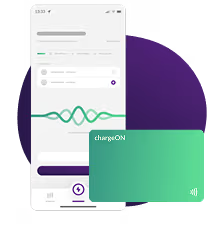chargeFleet: The control center for fleet managers
With chargeFleet, you can keep an eye on your e-fleet at all times and manage it efficiently. Our user-friendly web portal offers full cost transparency and makes it easier to manage authorizations, charging costs and energy consumption at charging stations. It also enables easy organization of charging card and user management for smooth operation.
Detailed overview of all charging processes and analyses of the fleet's charging behavior
User and charge card management
Access management, tariff planning and management of charging stations in the store
The best solution for your drivers too
The proven app offers drivers complete transparency of all charging transactions, including tax-compliant receipts directly in the app. If necessary, the driver can individually expand the app with an RFID charging card, which is particularly practical in areas with poor network coverage, such as underground car parks.
Easy to use app for drivers
Easy to find the available public, private or company-owned charging stations including price information via app
Ability to charge without a physical card with direct billing to the company
Verfügbare Ladestationen
Auf dieser Karte sehen sie alle öffentlich verfügbaren Ladestationen in ganz Europa. Mit dieser Abdeckung garantieren Sie ihren Fahrern einen zuverlässigen Begleiter für öffentliches Laden egal wo sie sich gerade befinden.
An overview of our solutions
chargeHome
For charging via an intelligent & offline wallbox or via a conventional household power outlet. Automatic setting of electricity tariffs by address and zip code.
chargeStation
For managing your own charging stations and controlling the user base as well as corresponding charging rates.
chargePublic
For flexible and convenient charging in public spaces — in Switzerland and Europe.
FAQs
If your question is not answered here, you can contact us directly.
VISA and Mastercard
Charges at AC stations (slow chargers) are preferred for normal daily use. DC stations (fast chargers) can be used for travel or to save time. In general, the faster the battery is charged, the more stress is exerted on it.
The vehicle should only be charged over 80% in exceptional cases, such as when traveling. This is to protect the battery.
Both the maximum charging capacity of the station and the maximum charging capacity of the vehicle represent values under optimal conditions. In reality, these are rarely present. In general, it can be said that a charging station always provides as much power as the vehicle requests. This means that if the charging station can provide 180 kW, but the vehicle only requests 50 kW, only 50 kW will be supplied. For a charging process to use the maximum charging power specified for the vehicle, a number of factors are crucial:
1) The temperature of the battery and the environment: If the battery is too warm or too cold, the car communicates with the charging station that it cannot charge at full power.
2) The age of the battery: The battery can degrade in performance and capacity due to age.
3) The current state of charge of the battery - SOC level: For the last 50%, charging performance can decrease depending on the car. This is to protect the battery.
4) The general charging curve of the vehicle: Depending on the manufacturer or model, this curve varies to a greater or lesser extent.
5) Power supply at the charging station: If there are many charging stations in one place, they have to share the charging power from the grid. It may then not be possible to provide full power at all charging stations.
6) Total power available at the charging station In these cases, our customer support cannot help. However, we generally do not limit the charging power of the charging stations.
There are various types of charging plugs that are used for charging electric vehicles. The most common types are:
Type 1 (SAE J1772): This plug is commonly used for AC charging in North America and Japan.
Type 2 (Mennekes): This plug is often used for AC charging in Europe and is compatible with most e-vehicles.
CCS (combined charging system): CCS plugs are primarily used for DC fast charging and are becoming increasingly popular all over the world.
CHAdeMO: This plug is also used for DC fast charging and is often found in older electric vehicle models, especially from Japanese manufacturers.
Choosing the right charging plug for your electric vehicle (EV) is essential for safe and efficient charging.
Here are a few steps to help you make the right choice:
- Check the compatibility of your vehicle: Different e-vehicle models may require different types of charging plugs. Check your vehicle's manual or contact the manufacturer to find out which type of plug is compatible with your electric vehicle.
- Find out about charging standards: There are various charging standards that are used worldwide, such as CHAdeMO, CCS (Combined Charging System) and Tesla's Supercharger. Find out which standard is common in your region and make sure that the charging plug you choose supports that standard.
- Take into account the charging speed: There are charging plugs in different power levels, which affect the charging speed. Determine your charging needs based on your daily driving habits. If you frequently take long trips, you might want to invest in a faster charging port.
- Evaluate plug types: There are various plug types, including Type 1 (J1772), Type 2 (Mennekes), and Type 3 (Same). When choosing the right type of plug for your vehicle, consider factors such as availability, compatibility with charging stations, and ease of use.
- Remember, it's always a good idea to consult an EV specialist or your vehicle manufacturer to make sure you're making the best choice for your particular EV model.
More about charging

Energy and mobility: Bringing together what belongs together

Swisscom optimizes e-mobility management with autoSense fleetCharge




